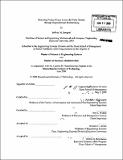Restoring product focus across the value stream through organizational restructuring
Author(s)
Pasqual, Jeffrey M. (Jeffrey Michael)
DownloadFull printable version (13.82Mb)
Other Contributors
Leaders for Manufacturing Program.
Advisor
Deborah J. Nightingale and Roy E. Welsch.
Terms of use
Metadata
Show full item recordAbstract
Businesses take deliberate action to change their internal context when managers believe that better performance lies beyond the capabilities of assets in their present configuration. A typical course of action is reorganization. A key consideration for organizational design is how the relationship between an organization's structure, the structure of its products, and the structure of its processes influence the value delivered to customers. In some sense, products, processes, and the organization should "fit" each other. This thesis presents a framework for thinking about product architecture, enterprise architecture, and the value stream of processes that binds them together. Critical to any enterprise architecture are process owners that control and improve organizational processes and product owners that manage the end-to-end development of products. When a product is significantly complex, independent tiers of product ownership might be established to ensure that different levels of products - systems, subsystems, or components - are managed with appropriate developmental objectives in mind. For example, some components must be distinct to a single product; other components can be common among several products. The proposed framework shows how product and enterprise architectures can be integrated to support the development of complex systems. The thesis also presents a case study to which the proposed framework is applied. The study focuses on a business that has recently restructured its organization to achieve better alignment with the complex products it develops. Using the proposed framework, the new organizational structure is evaluated to determine if the new enterprise architecture positions the business to increase customer value and accomplish its long-term goals.
Description
Thesis (S.M.)--Massachusetts Institute of Technology, Engineering Systems Division; and, (M.B.A.) -- Massachusetts Institute of Technology, Sloan School of Management; in conjunction with the Leaders for Manufacturing Program at MIT, 2008. Includes bibliographical references (p. 93-94).
Date issued
2008Department
Sloan School of Manufacturing.; Leaders for Manufacturing Program at MIT; Massachusetts Institute of Technology. Engineering Systems Division; Sloan School of ManagementPublisher
Massachusetts Institute of Technology
Keywords
Engineering Systems Division., Sloan School of Manufacturing., Leaders for Manufacturing Program.